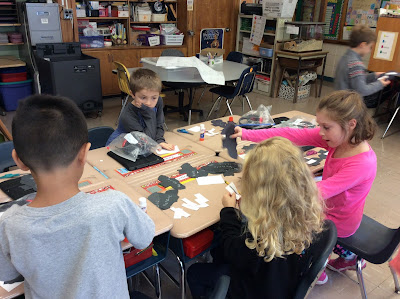 |
| Arianna |
 |
| Ben |
In math we finished our introductory topic about different strategies for adding and subtracting numbers and began our second topic: working with equal groups. In this unit we are focused on the following vocabulary words: array, column, row, bar diagram, even and odd. We are learning how to match equations to arrays and draw arrays of objects that match equations. Understanding rows and columns help us write our equations!
In Miss Varrell's Fundations class we have been learning about bonus letters (f, l, and s), glued sounds (all, am, an) and homophones (e.g. to~two~too). The bonus letters f and s are usually found immediately after short vowels and at the end of a syllable, but the bonus letter l is special because it often changes the sound of the vowel a little bit:
stuffing cliff
classes Massachusetts
rolled mall
Glued sounds are made up of a vowel and a consonant (or two) where the vowel sound changes in a very small way so that it doesn't make a short sound, but it's not a long sound either. English is so confusing!
ball wall
ham Wham!
can ran
Homophones are words that sound the same but are spelled differently and have different meanings. Students came up with a list of homophones for a "Going Batty for Homophones" activity this week. Here is our list from two days of brainstorming:
 |
| After three days of brainstorming: "Wow! That's a lot of batty homophones, Miss Varrell!" |
"What is happening so far?"
or
"What is happening now?"
When we stop to check in with our understanding as we read, we are more likely to comprehend at a deeper level throughout the text.
In Writing Workshop we continued working on our narratives. We have gradually increased our writing stamina over the past few weeks so that we can write for thirty minutes in one session! Our most recent mini lessons have focused on:
- using an illustration to inspire a narrative piece of writing
- rereading our own writing to find new ideas to continue the narrative
- rereading to look/listen for places to fix/improve our writing
- numbering pages to keep narrative stories in the order the author intends
| Photo Credit: Ben |
| Photo Credit: Arianna |
We read a book by Patricia Lauber called Be A Friend to Trees where we learned about the ways that trees are a positive and integral part of our lives and the lives of animals. We also learned that the sticky substance sap that we discovered on our leaf walk last week is just sugar-water that a tree makes as its source of food. We also learned that the leaves of a tree collect sunlight and air and in combination with the water absorbed by the roots, use a process called photosynthesis to make this sugar-water "food." Different types of tree sap (sometimes called pitch or resin, in its less liquid form) can be used to make different products such as maple syrup, rubber, chewing gum and paint thinner.
Parent F.Y.I.
- Field Trip slips went home last Thursday. If you did not see a permission slip come home, please let me know and I will send a new form home with your child. Thank you for continuing to send in completed forms and field trip payments.
- As the weather changes from fall to winter children will have a greater need for warmer outerwear. Please be sure that hats, gloves, mittens and jackets have an identifying label somewhere inside each garment so that they can be returned if lost on the playground or bus. Outdoor recess will only be changed in favor of indoor recess when temperatures are considered too dangerous and/or precipitation is too heavy.
- Have a great weekend!














No comments:
Post a Comment